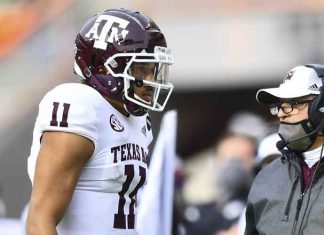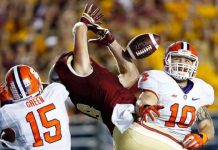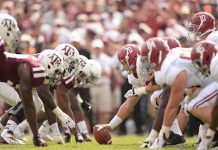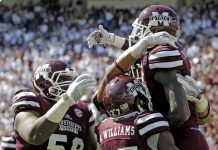Bear Bryant said offense sells tickets, and he was right. College football is enjoying immense popularity in an era of record scoring.
But is there too much of a good thing?
All that scoring caused this season’s average length of game to hit 3 hours, 23 minutes in late November, according to the NCAA. That was up from 3:17 last season. Games are, on average, 14 minutes longer than in 2008. By comparison, this season’s NFL average is 3:07.
”I think it’s trending in the wrong direction, and it is a concern,” American Athletic Conference commissioner Mike Aresco said.
Administrators are wary of turning off fans, especially young ones who crave faster action and represent future ticket buyers. They also are mindful of the risk of injury to fatigued players who are on the field longer and for more plays.
The NCAA Football Rules Committee expects to discuss the issue when it meets in February, secretary-rules editor Rogers Redding said.
”The 14-minute increase has been gradual” since 2008, he wrote in an email to The Associated Press, ”but the cumulative effect has generated some concern among some stakeholders so that it is probably something that the committee will want to take a look at.”
Increasing game lengths prompted rules changes in 2008. One shortened the interval between when the clock stopped and restarted on plays that end out of bounds. Another required the 40-second play clock to start right when the previous play is blown dead.
No changes are imminent for 2015, but a number of ideas have been proposed. They include shortening halftime from 20 to 12 minutes and keeping the game clock running while the chains are moved after first downs. Another idea is to allow the quarterback and one defensive player to have earpieces in their helmets to allow for radio contact with coaches and streamline communication, as in the NFL.
Mid-American Conference commissioner Jon Steinbrecher, who chairs the College Football Officiating Board of Managers, said it’s imperative to keep the average game under 3:30. That figure coincides with the typical window TV networks allot for a game.
”A shorter game is better than a longer game. That’s painting with a broad brush,” Steinbrecher said. ”If a game is exciting, I suppose it doesn’t matter how long it takes. We ought to probably be in that 3:15 to 3:20 range.”
Baylor’s 61-58 win over TCU on Oct. 11 – at 4 hours, 25 minutes – was the season’s longest game that didn’t go overtime or wasn’t delayed by weather, according to STATS. Temple’s 59-0 win over Delaware State on Sept. 20 – at 2:40 – was the shortest.
Video reviews and the demands of television play a role in game times, but they are secondary to the increased scoring, administrators said.
The average number of game stops for the replay official to review a play has held steady at 1.7 to 1.9 a game. The average duration of those stoppages is down to 1 minute, 15 seconds this season from a high of 1:22 in 2011.
Television agreements vary by conference and network, but generally there are three or four commercial breaks of differing lengths per quarter.
”In this world, you always want to make sure that if a TV commercial break is 2 minutes, 30 seconds, it’s 2 minutes 30 seconds and not three minutes,” Big Ten senior associate commissioner for television administration Mark Rudner said. ”TV has a stake in it, too. The last thing TV wants to do is have a game that goes too long and miss a game that is coming up.”
ESPN senior vice president Burke Magnus said as long as the average game doesn’t extend past 3 1/2 hours, his network sees no problem.
The issue comes back to those high-producing offenses.
In the NFL, the average number of offensive plays is 64 a game. It’s 72 in the top tier of college football.
The NFL scoring average is 22.7 points. In the Bowl Subdivision it’s 29.4, the same as last year and just under the record of 29.5 in 2012.
The game clock stops for three to four minutes every time there’s a touchdown. That’s how long it takes to kick the extra point and for the clock to start running again on the kick return or next play from scrimmage if there is no runback.
Though college football attendance remains robust, administrators are always looking for ways to draw fans away from their high-definition TVs at home and to the stadium. Once there, they need to be entertained when the game is in a lull.
Some schools have hired ”fan experience” directors to keep game day fun. Wifi has been enhanced at stadiums, and bigger-than-ever video boards have been installed. Still, many schools are seeing declines in student ticket sales. Those students represent the future fan base.
”People want the experience,” said Jim Kahler, executive director of Ohio University’s Center for Sports Administration, ”but they want it convenient and they want it fast.”
—
AP Sports Writer Rachel Cohen in New York contributed to this report.
25% Bonus via Western Union

















